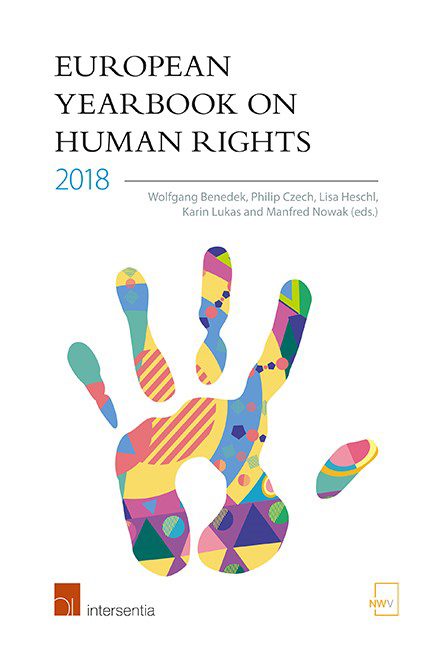Book contents
- Frontmatter
- Scientific Advisory Board
- Editors’ Preface
- Contents
- List of Abbreviations
- List of Contributors
- Part I Topic Of The Year
- Part II Eu
- Part III Coe
- PART IV OSCE
- Part V Others
- Part VI Book Reviews
- Katja S. Ziegler, Elizabeth Wicks and Loveday Hodson (eds.): The UK and European Human Rights – A Strained Relationship?
- Emily Reid: Balancing Human Rights, Environmental Protection and International Trade – Lessons from the EU Experience
- Nicole Bürli: Third-Party Interventions before the European Court of Human Rights
- Stijn Smet and Eva Brems (eds.): When Human Rights Clash at the European Court of Human Rights – Conflict or Harmony?
- Violeta Moreno-Lax: Accessing Asylum in Europe, Oxford Studies in European Law
- Mark Dawson: The Governance of EU Fundamental Rights
- Philip Leach: Taking a Case to the European Court of Human Rights, 4th Edition
- Sionaidh Douglas-Scott and Nicholas Hatzis (eds.): Research Handbook on EU Law and Human Rights
- Lauri Mälksoo and Wolfgang Benedek (eds.): Russia and the European Court of Human Rights – The Strasbourg Effect
- Index
Violeta Moreno-Lax: Accessing Asylum in Europe, Oxford Studies in European Law
from Part VI - Book Reviews
Published online by Cambridge University Press: 31 January 2019
- Frontmatter
- Scientific Advisory Board
- Editors’ Preface
- Contents
- List of Abbreviations
- List of Contributors
- Part I Topic Of The Year
- Part II Eu
- Part III Coe
- PART IV OSCE
- Part V Others
- Part VI Book Reviews
- Katja S. Ziegler, Elizabeth Wicks and Loveday Hodson (eds.): The UK and European Human Rights – A Strained Relationship?
- Emily Reid: Balancing Human Rights, Environmental Protection and International Trade – Lessons from the EU Experience
- Nicole Bürli: Third-Party Interventions before the European Court of Human Rights
- Stijn Smet and Eva Brems (eds.): When Human Rights Clash at the European Court of Human Rights – Conflict or Harmony?
- Violeta Moreno-Lax: Accessing Asylum in Europe, Oxford Studies in European Law
- Mark Dawson: The Governance of EU Fundamental Rights
- Philip Leach: Taking a Case to the European Court of Human Rights, 4th Edition
- Sionaidh Douglas-Scott and Nicholas Hatzis (eds.): Research Handbook on EU Law and Human Rights
- Lauri Mälksoo and Wolfgang Benedek (eds.): Russia and the European Court of Human Rights – The Strasbourg Effect
- Index
Summary
The book is dedicated to one of the central factual and legal problems refugees have been facing for many years when they intend to seek asylum in Europe or–according to the author‘s terminology–exercise the EU ‘ right to flee ‘ (pp. 393f., 474f.). They need to get access to the territory or–to be more precise–to the jurisdiction of a Member State of the European Union (EU) in order to submit their claim for international protection. The monograph analyses in a comprehensive and illustrative way the development of various kinds of measures created with the intention to deny or limit this access.
The book written by Violeta Moreno-Lax is divided into two main parts. Each part consists of five chapters. Part 1 covers the various types of EU preborder and extraterritorial border control systems and their implications for access to protection in Europe. These measures include, inter alia, visa obligations, sanctions against carriers who transport persons not holding valid entry papers and also pre-emptive controls in maritime areas. Part II starts with an examination of legal obligations of Member States when they carry out extraterritorial acts. The other chapters of Part II are dedicated to the tension between these measures and obligations under the fundamental rights acquis of the EU.
The problems are not new in general, but the increase of persons seeking access to asylum procedures in the last three years and the reactions of Member States added new legal questions to the already existing ones concerning their human rights compatibility. Even between the publication of the present monograph and the writing of the review new measures were created to limit the options to reach Europe via the Mediterranean Sea or even to restrict the possibilities to leave the ports or territorial waters of countries of departure.
In Part I the author starts with a clarifying reconstruction of the externalisation of border control measures. She lucidly points to the emergence of the concept of ‘ Integrated Border Management ‘ and the various regimes, which may be summarised under this heading. The creation and development of the Schengen system, the nearly uniform visa regime and the delegation of powers to liaison officers are scrutinised in detail.
- Type
- Chapter
- Information
- European Yearbook on Human Rights 2018 , pp. 609 - 612Publisher: IntersentiaPrint publication year: 2018



